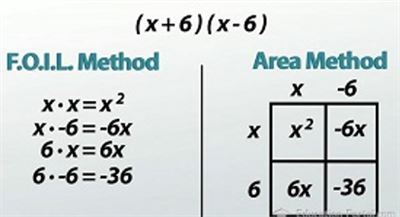Multiplying Binomials
Kind of like learning your times tables, multiplying binomials is one of those skills that can start out slow but with some practice become really fast and easy. This lesson is here to help you move from slow and unsure to fast and confident!
Because there are so many different ways to multiply two binomials, we'll do each problem in this lesson two ways. I won't explain both ways word-for-word in each problem, but we'll have both ways going on the screen at once so you can pick which of them you like more and also see how they're basically the same thing. Feel free to pause the lesson when I introduce a problem and give it a shot on your own before you watch me do it. That way you can either focus on the specific mistake you make or quickly skip through the problem if you got it right!
Example #1
Let's start with a pretty basic one.
Multiply (x + 6)(x - 6)
We'll use the FOIL method on the left side of the screen and the area method on the right. Remember that both are simply procedures that help you remember the four mini-multiplication problems that these examples will break down into. FOIL uses an acronym to help you remember which things to multiply, while the area method uses a chart to do the same thing. FOIL is a little bit quicker but also easier to make mistakes with, while the area method takes a little bit more time because you need to draw out the chart, but it's much better at preventing silly mistakes.

Because the numbers aren't too bad on this one, I'll go ahead and use FOIL. That means I begin by multiplying the First terms, x and x, to get x2.
Then we do the Outer terms, x and -6, to get -6x.
The Inner terms, 6 and x, give us 6x.
And finally we have the Last terms, 6 and -6, leaving us with a -36 on the end.
x2 - 6x + 6x - 36
We're already basically done, but we'd like to simplify our answer by combining like terms. I've got two groups of xs here, and when we do -6x + 6x, they will actually cancel each other out, leaving our answer as simply:
x2 - 36
Now, there is actually a shortcut to answering problems like this where you are multiplying two conjugates together. Two binomials are conjugates if they have the same two terms but opposite signs on the second one like (a + b) and (a - b). Any time we multiply two conjugates together, the two middle terms will drop out, just like we saw, giving us the shortcut:
(a + b)(a - b) = a2 - b2